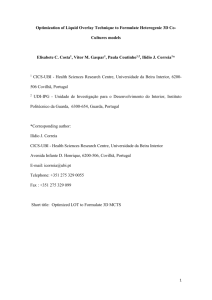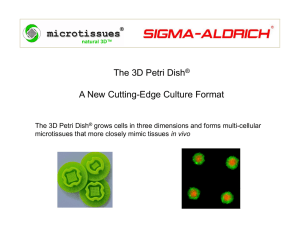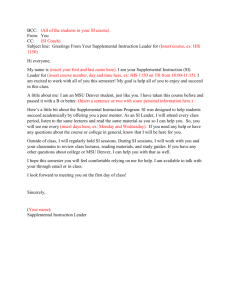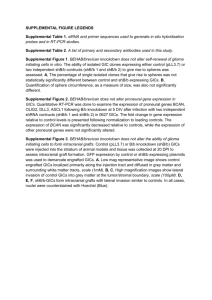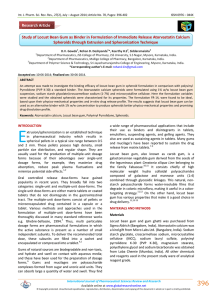APG101 inhibits Glioma cell invasion Supplemental Materials and
advertisement
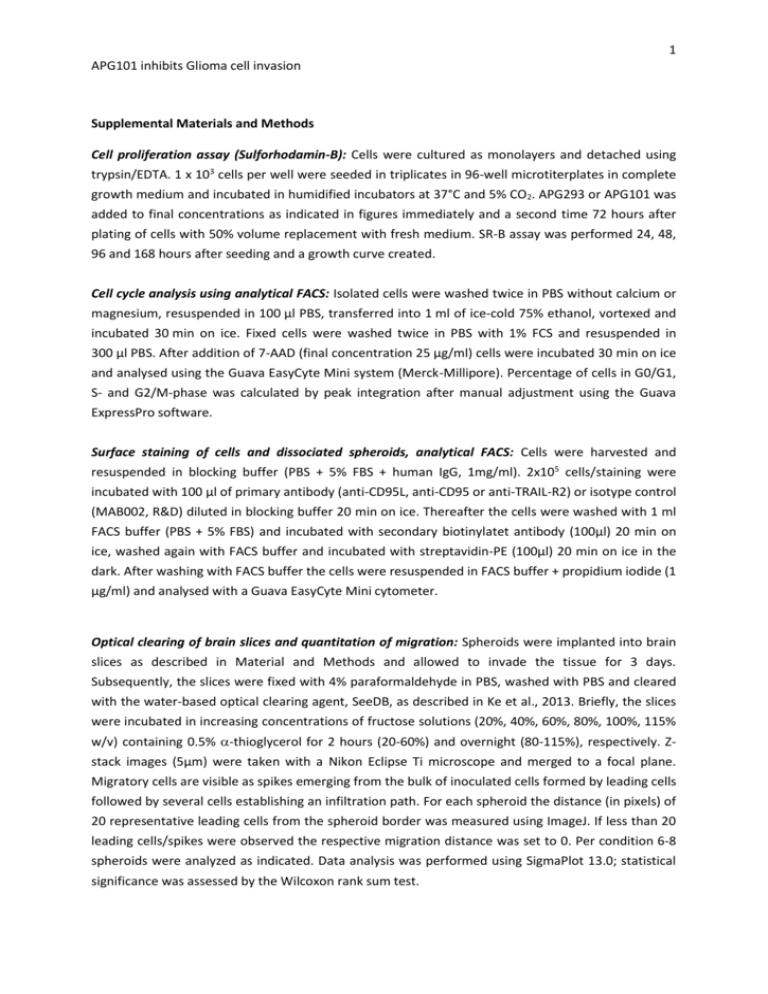
1 APG101 inhibits Glioma cell invasion Supplemental Materials and Methods Cell proliferation assay (Sulforhodamin-B): Cells were cultured as monolayers and detached using trypsin/EDTA. 1 x 103 cells per well were seeded in triplicates in 96-well microtiterplates in complete growth medium and incubated in humidified incubators at 37°C and 5% CO2. APG293 or APG101 was added to final concentrations as indicated in figures immediately and a second time 72 hours after plating of cells with 50% volume replacement with fresh medium. SR-B assay was performed 24, 48, 96 and 168 hours after seeding and a growth curve created. Cell cycle analysis using analytical FACS: Isolated cells were washed twice in PBS without calcium or magnesium, resuspended in 100 µl PBS, transferred into 1 ml of ice-cold 75% ethanol, vortexed and incubated 30 min on ice. Fixed cells were washed twice in PBS with 1% FCS and resuspended in 300 µl PBS. After addition of 7-AAD (final concentration 25 µg/ml) cells were incubated 30 min on ice and analysed using the Guava EasyCyte Mini system (Merck-Millipore). Percentage of cells in G0/G1, S- and G2/M-phase was calculated by peak integration after manual adjustment using the Guava ExpressPro software. Surface staining of cells and dissociated spheroids, analytical FACS: Cells were harvested and resuspended in blocking buffer (PBS + 5% FBS + human IgG, 1mg/ml). 2x105 cells/staining were incubated with 100 µl of primary antibody (anti-CD95L, anti-CD95 or anti-TRAIL-R2) or isotype control (MAB002, R&D) diluted in blocking buffer 20 min on ice. Thereafter the cells were washed with 1 ml FACS buffer (PBS + 5% FBS) and incubated with secondary biotinylatet antibody (100µl) 20 min on ice, washed again with FACS buffer and incubated with streptavidin-PE (100µl) 20 min on ice in the dark. After washing with FACS buffer the cells were resuspended in FACS buffer + propidium iodide (1 µg/ml) and analysed with a Guava EasyCyte Mini cytometer. Optical clearing of brain slices and quantitation of migration: Spheroids were implanted into brain slices as described in Material and Methods and allowed to invade the tissue for 3 days. Subsequently, the slices were fixed with 4% paraformaldehyde in PBS, washed with PBS and cleared with the water-based optical clearing agent, SeeDB, as described in Ke et al., 2013. Briefly, the slices were incubated in increasing concentrations of fructose solutions (20%, 40%, 60%, 80%, 100%, 115% w/v) containing 0.5% -thioglycerol for 2 hours (20-60%) and overnight (80-115%), respectively. Zstack images (5µm) were taken with a Nikon Eclipse Ti microscope and merged to a focal plane. Migratory cells are visible as spikes emerging from the bulk of inoculated cells formed by leading cells followed by several cells establishing an infiltration path. For each spheroid the distance (in pixels) of 20 representative leading cells from the spheroid border was measured using ImageJ. If less than 20 leading cells/spikes were observed the respective migration distance was set to 0. Per condition 6-8 spheroids were analyzed as indicated. Data analysis was performed using SigmaPlot 13.0; statistical significance was assessed by the Wilcoxon rank sum test. 2 APG101 inhibits Glioma cell invasion Supplemental Figures & Legends Supplemental figure S1: Sulforhodamin-B assay: Proliferation of U87-MG and U251-MG cells was determined by quantitation of total protein amount 24 hours, 48 hours, 96 hours and 168 hours after seeding of 1000 cells/well in 96-well microtiter plates and treatment with indicated amounts of APG293 or APG101. Proliferation rates are not significantly reduced by escalating doses of APG293 and APG101, exceeding compound doses used for the in vitro/ex vivo studies. 3 APG101 inhibits Glioma cell invasion Supplemental figure S2: Cell cycle analysis of U251-MG cells after treatment with APG293 or APG101. Cells were incubated with indicated amounts of recombinant proteins for 48 hours detached with trypsin, fixed with ethanol and stained with 7AAD. Analysis of DNA content was performed on a Guava EasyCyte Mini system (Merck-Millipore). Blue indicates cells in G0/G1 phase, green = cells in G2/M phase, purple = cells in S phase. 4 APG101 inhibits Glioma cell invasion Supplemental figure S3: Matrigel spheroid invasion assay. Dose-dependent inhibition of invasion by APG101. Spheroids were initiated from U87[CD95L] knockdown cells and embedded in matrigel containing 10 ng/ml APG293 with or without APG101 in indicated amounts. Invasion of cells is followed over a period of 72 hours. Shown are spheroids after 24 hours and 72 hours. 5 APG101 inhibits Glioma cell invasion Supplemental figure S4: Visualization of spheroid migration after SeeDB clearing of brain slices. Murine brain tissue slices were pretreated for 12 hours with medium only or with medium containing 10 ng/ml APG293 in the presence or absence of 50 µg/ml APG101, or 50 µg/ml APG122. Subsequently, fluorescence-labeled U87[CD95L] knockdown cell spheroids were implanted into the pre-incubated brain slices. LY294002 (5 µg/ml) was added before spheroid implantation. During the assay APG293 was omitted while treatment with APG101, APG122 and LY294002 was continued. The brain slices were fixed after 3 days and cleared using the SeeDB protocol described in Supplemental Materials and Methods. Two representative images are shown for each treatment. Scale bar: 200 m. 6 APG101 inhibits Glioma cell invasion Supplemental figure S5: Detection of cleaved CD95L in supernatants of single GBM spheroid cultures by ELISA. Single spheroids were seeded from U87 and U251 control transfected and knockdown cells (5000 cells per well in agarose coated microtiter plates) and grown for 7 days without medium change. Supernatants of 16 individual spheroids (200 µl each well) were then used for analysis of CD95 ligand by ELISA as described in the manuscript. Human recombinant CD95L (APG293) was used to generate a calibration curve (90 pg/ml to 0,123 pg/ml). Concentration of CD95L in spheroid supernatants was recalculated against a calibration curve from OD450 values in GraphPad Prism. Shown are data from supernatants of 16 individual spheroids each. 7 APG101 inhibits Glioma cell invasion Supplemental figure S6 (A): Detection of membrane bound CD95L presented by monolayer cells or dissociated spheroids of U87[SCRMBL] and U87[CD95L] knockdown cell cultures by analytical flow cytometry. Monolayer cultures and spheroids were kept in growth medium for 5 days and cells then dissociated by trypsination. Flow cytometry analysis of single cell suspensions was performed following surface labeling of cell suspensions with indicated antibodies against CD95L, CD95 and TRAIL receptor 2 (TRAIL-R2) as described in Supplemental Materials and Methods. 8 APG101 inhibits Glioma cell invasion Supplemental figure S6 (B): Detection of membrane bound CD95L presented by monolayer cells or dissociated spheroids of U251[SCRMBL] and U251[CD95L] knockdown cell cultures by analytical flow cytometry. Monolayer cultures and spheroids were kept in growth medium for 5 days and cells then dissociated by trypsination. Flow cytometry analysis of single cell suspensions was performed following surface labeling of cell suspensions with indicated antibodies against CD95L, CD95 and TRAIL receptor 2 (TRAIL-R2) as described in Supplemental Materials and Methods. 9 APG101 inhibits Glioma cell invasion Supplemental figure S7: Quantitation data from figure 4 A. Basal invasiveness of transfected glioma cell spheroids. An even radial grid in 20° steps was projected on spheroids depicted in figure 5 and radial distance of farthest invaded cell along the gridlines determined. The mean radial distance after 72 hours was then divided by mean radius of spheroids at time point 0 hours. Migration distance of cells is shown as the fold-increase of mean radius after 72 hours for U87- and U251-derived spheroids after control transfection [SCRMBL] or specific knockdown [CD95L] as described in Materials and Methods. No treatment was applied to the spheroids before or during the assay. 10 APG101 inhibits Glioma cell invasion Supplemental figure S8: Quantitation data from figure 5. APG293 induced invasion of spheroids with [CD95L] knockdown. An even radial grid in 20° steps was projected on spheroids depicted in figure 5 and radial distance of farthest invaded cell along the gridline determined. The mean radial distance after 72 hours was then divided by mean radius of spheroids at time point 0 hours. Migration distance of cells is shown as the fold-increase of mean radius after 72 hours for U87- and U251-derived spheroids after specific knockdown [CD95L]. Treatment indicated in figure and described in Materials and Methods. 11 APG101 inhibits Glioma cell invasion Supplemental figure S9: In vitro spheroid invasion assay. Left panel: Matrigel (growth factor reduced, BD Biosciences) was used at a protein concentration of 3 mg/ml and supplemented with 10 ng/ml APG293 alone or in combination with 100 µg/ml APG101 and 10 µM LY294002 (non-isotype specific PI3K-inhibitor), respectively. Spheroids of U87[SCRMBL] and U87[CD95L] knockdown cells were implanted in matrigel and invasion allowed for 72 hours. Pictures of spheroids were taken immediately after implantation and after 72 hours. Right panel: Mean radial distance from the center of the spheroid was measured after 72 hours for n = 20 invaded cells and is expressed as quotient of mean radial distance at 72 hours/mean radius at 0 hours. Migration distance of cells is depicted as fold-increase of mean radius after 72 hours. 12 APG101 inhibits Glioma cell invasion Supplemental figure S10 13 APG101 inhibits Glioma cell invasion Supplemental Figure S10 (continued): Quantitation of glioma cell migration in organotypic murine brain slices. Spheroids from DiI-labeled glioma cells cells were inoculated into organotypic C57BL/6 mouse brain slices and allowed to invade the tissue for 3 days. Subsequently, the brain slices were fixed and cleared and migration was analyzed as described in Supplemental Materials and Methods for the indicated number of spheroids per treatment. Data are depicted as box plots with median, outliers and 5/95 percentile. Statistical significance was assessed by Wilcoxon rank sum test, ** p<0.01, *** p<0.001. (A) U251[SCRMBL] and U251[CD95L] cell spheroids were implanted into brain slices pretreated with control medium or pretreated over night with medium containing APG293 (10 ng/ml), APG293 (10 ng/ml) + APG101 (50 µg/ml), or APG293 (10 ng/ml) + APG122 (50 µg/ml). (B) U87[SCRMBL] and U87[CD95L] cell spheroids were implanted into brain slices pretreated with control medium or pretreated over night with medium containing APG293 (10 ng/ml), or APG293 (10 ng/ml) + APG101 (50 µg/ml). LY294002 (5 µg/ml) was added before spheroid implantation. (C) U87[CD95L] and U251[CD95L] cell spheroids were implanted into brain slices pretreated with control medium or pretreated over night with medium containing APG293 (10 ng/ml), APG293 (10 ng/ml) + APG101 (50 µg/ml), or APG293 (10 ng/ml) + APG122 (50 µg/ml). LY294002 (5 µg/ml) was added before spheroid implantation. For each experiment treatment with the inhibitors was maintained after spheroid inoculation while APG293 was omitted.
